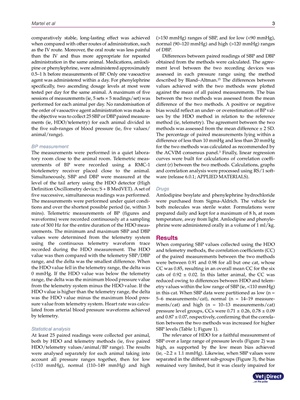
Martel et al 3
comparatively stable, long-lasting effect was achieved
when compared with other routes of administration, such
as the IV route. Moreover, the oral route was less painful
than the IV and thus more appropriate for repeated
administration in the same animal. Medications, amlodipine or phenylephrine, were
administered approximately
0.5-1 h before measurements of BP. Only one vasoactive
agent was administered within a day. For phenylephrine
specifically, two ascending dosage levels at most were
tested per day for the same animal. A maximum of five
sessions of measurements (ie, 5 sets × 5 readings/set) was
performed for each animal per day. No randomisation of
the order of vasoactive agent administration was made as
the objective was to collect 25 SBP or DBP paired measurements
(ie, HDO/telemetry) for each animal divided in
the five sub-ranges of blood pressure (ie, five values/
animal/range).
BP measurement
The measurements were performed in a quiet laboratory room
close to the animal room. Telemetric measurements
of BP were recorded using a RMC-1
biotelemetry receiver placed close to the animal.
Simultaneously, SBP and DBP were measured at the
level of the tail artery using the HDO detector (High
Definition Oscillometry device; S + B MedVET). A set of
five successive, simultaneous readings was performed.
The measurements were performed under quiet conditions and
over the shortest possible period (ie, within 3
mins). Telemetric measurements of BP (figures and
waveforms) were recorded continuously at a sampling
rate of 500 Hz for the entire duration of the HDO measurements.
The minimum and maximum SBP and DBP
values were determined from the telemetry system
using the continuous telemetry waveform trace
recorded during the HDO measurement. The HDO
value was then compared with the telemetry SBP/DBP
range, and the delta was the smallest difference. When
the HDO value fell in the telemetry range, the delta was
0 mmHg. If the HDO value was below the telemetry
range, the delta was the minimum blood pressure value
from the telemetry system minus the HDO value. If the
HDO value is higher than the telemetry range, the delta
was the HDO value minus the maximum blood pressure
value from telemetry system. Heart rate was calculated
from arterial blood pressure waveforms achieved
by telemetry.
Statistical analysis
At least 25 paired readings were collected per animal,
both by HDO and telemetry methods (ie, five paired
HDO/telemetry values/animal/BP range). The results
were analysed separately for each animal taking into
account all pressure ranges together, then for low
(<110 mmHg), normal (110-149 mmHg) and high
(>150 mmHg) ranges of SBP, and for low (<90 mmHg),
normal (90-120 mmHg) and high (>120 mmHg) ranges
of DBP.
Differences between paired readings of SBP and DBP
obtained from the methods were calculated. The agreement level between the two recording
devices was
assessed in each pressure range using the method
described by Bland-Altman.15 The differences between
values achieved with the two methods were plotted
against the mean of all paired measurements. The bias
between the two methods was assessed from the mean
difference of the two methods. A positive or negative
bias would reflect an under- or overestimation of BP values by the HDO method in relation
to the reference
method (ie, telemetry). The agreement between the two
methods was assessed from the mean difference ± 2 SD.
The percentage of paired measurements lying within a
difference of less than 10 mmHg and less than 20 mmHg
for the two methods was calculated as recommended by
the ACVIM consensus panel.3 Finally, linear regression
curves were built for calculations of correlation coefficient (r) between the two methods. Calculations, graphs
and correlation analysis were processed using RS/1 software
(release 6.0.1; APPLIED MATERIALS).
Drugs
Amlodipine besylate and phenylephrine hydrochloride
were purchased from Sigma-Aldrich. The vehicle for
both molecules was sterile water. Formulations were
prepared daily and kept for a maximum of 8 h, at room
temperature, away from light. Amlodipine and phenylephrine were
administered orally in a volume of 1 ml/kg.
Results
When comparing SBP values collected using the HDO
and telemetry methods, the correlation coefficients (CC)
of the paired measurements between the two methods
were between 0.91 and 0.98 for all but one cat, whose
CC was 0.85, resulting in an overall mean CC for the six
cats of 0.92 ± 0.02. In this latter animal, the CC was
reduced owing to differences between HDO and telemetry values within the low range of SBP
(ie, <110 mmHg)
in this cat. When SBP data were partitioned as low (n =
5-6 measurements/cat), normal (n = 14-19 measurements/cat) and high (n = 10-13 measurements/cat)
pressure level groups, CCs were 0.71 ± 0.26, 0.78 ± 0.09
and 0.87 ± 0.07, respectively, confirming that the correlation between the two methods was increased
for higher
SBP levels (Table 1; Figure 1).
The relevance of HDO for a faithful measurement of
SBP over a large range of pressure levels (Figure 2) was
high, as supported by the low mean bias achieved
(ie, -2.2 ± 1.1 mmHg). Likewise, when SBP values were
separated in the different sub-groups (Figure 3), the bias
remained very limited, but it was clearly impaired for